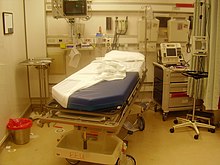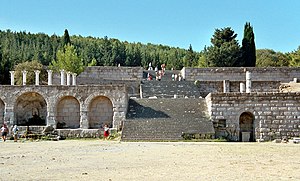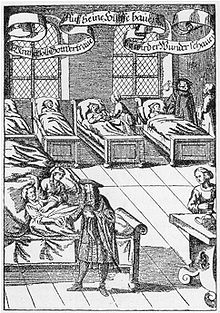Hospital: Difference between revisions
→Medieval Islamic world: elaborated |
No edit summary |
||
| Line 5: | Line 5: | ||
[[File:AIIMS central lawn.jpg|thumb|right|[[All India Institute of Medical Sciences]] in [[Delhi]], India]] |
[[File:AIIMS central lawn.jpg|thumb|right|[[All India Institute of Medical Sciences]] in [[Delhi]], India]] |
||
A '''hospital''' is an institution for [[health care]] providing [[patient]] treatment by specialized staff and equipment, and often, but not always providing for longer-term patient stays. |
A '''hospital''' is an institution for [[health care]] providing [[patient]] treatment by specialized staff and equipment, and often, but not always providing for longer-term patient stays. Aplace where dead people go |
||
Today, hospitals usually are [[publicly funded healthcare|funded by the public sector]], by health organizations, ([[For-profit hospital|for profit]] or [[Non-profit organization|nonprofit]]), [[health insurance]] companies or [[Charitable organization|charities]], including by direct charitable donations. In history, however, hospitals often were founded and funded by religious orders or charitable individuals and leaders. Similarly, modern-day hospitals are largely staffed by professional [[physician]]s, [[surgeon]]s, and [[nurse]]s, whereas in history, this work usually was performed by the founding religious orders or by [[volunteering|volunteers]]. |
Today, hospitals usually are [[publicly funded healthcare|funded by the public sector]], by health organizations, ([[For-profit hospital|for profit]] or [[Non-profit organization|nonprofit]]), [[health insurance]] companies or [[Charitable organization|charities]], including by direct charitable donations. In history, however, hospitals often were founded and funded by religious orders or charitable individuals and leaders. Similarly, modern-day hospitals are largely staffed by professional [[physician]]s, [[surgeon]]s, and [[nurse]]s, whereas in history, this work usually was performed by the founding religious orders or by [[volunteering|volunteers]]. |
||
Revision as of 13:32, 8 March 2010


A hospital is an institution for health care providing patient treatment by specialized staff and equipment, and often, but not always providing for longer-term patient stays. Aplace where dead people go
Today, hospitals usually are funded by the public sector, by health organizations, (for profit or nonprofit), health insurance companies or charities, including by direct charitable donations. In history, however, hospitals often were founded and funded by religious orders or charitable individuals and leaders. Similarly, modern-day hospitals are largely staffed by professional physicians, surgeons, and nurses, whereas in history, this work usually was performed by the founding religious orders or by volunteers.
Etymology
During the Middle Ages the hospital could serve other functions, such as almshouse for the poor, hostel for pilgrims, or hospital school. The name comes from Latin hospes (host), which also is the root for the English words hotel, hostel, and hospitality. The modern word hotel derives from the French word hostel, which featured a silent s, eventually removed from the word to leave a circumflex on modern French hôtel. The word also is related to the German word 'Spital'.
Grammar of the word differs slightly depending on the dialect. In the U.S., hospital usually requires an article; in Britain and elsewhere, the word normally is used without an article when it is the object of a preposition and when referring to a patient ("in/to the hospital" vs. "in/to hospital"); in Canada, both uses are found.
Types
Some patients go to a hospital just for diagnosis, treatment, or therapy and then leave ('outpatients') without staying overnight; while others are 'admitted' and stay overnight or for several weeks or months ('inpatients'). Hospitals usually are distinguished from other types of medical facilities by their ability to admit and care for inpatients and the others often are described as a clinic.
General
The best-known type of hospital is the general hospital, which is set up to deal with many kinds of disease and injury, and typically has an emergency department to deal with immediate and urgent threats to health. A general hospital typically is the major health care facility in its region, with large numbers of beds for intensive care and long-term care; and specialized facilities for surgery, plastic surgery, childbirth, bioassay laboratories, and so forth. Larger cities may have many several hospitals of varying sizes and facilities. Some hospitals, especially in the United States, have their own ambulance service.
Specialized
Types of specialized hospitals include trauma centers, rehabilitation hospitals, children's hospitals, seniors' (geriatric) hospitals, and hospitals for dealing with specific medical needs such as psychiatric problems (see psychiatric hospital), certain disease categories, and so forth.
A hospital may be a single building or a number of buildings on a campus. Many hospitals with pre-twentieth-century origins began as one building and evolved into campuses. Some hospitals are affiliated with universities for medical research and the training of medical personnel such as physicians and nurses, often called teaching hospitals. Worldwide, most hospitals are run on a nonprofit basis by governments or charities. Within the United States, most hospitals are nonprofit.[citation needed]
Teaching
A teaching hospital combines assistance to patients with teaching to medical students and nurses and often is linked to a medical school or nursing school. Some of these are associated with universities
Clinics
A medical facility smaller than a hospital is generally called a clinic, and often is run by a government agency for health services or a private partnership of physicians (in nations where private practice is allowed). Clinics generally provide only outpatient services.
Departments

Hospitals vary widely in the services they offer and therefore, in the departments they have. They may have acute services such as an emergency department or specialist trauma centre, burn unit, surgery, or urgent care. These may then be backed up by more specialist units such as cardiology or coronary care unit, intensive care unit, neurology, cancer center, and obstetrics and gynecology.
Some hospitals will have outpatient departments and some will have chronic treatment units such as behavioral health services, dentistry, dermatology, psychiatric ward, rehabilitation services, and physical therapy.
Common support units include a dispensary or pharmacy, pathology, and radiology, and on the non-medical side, there often are medical records departments and/or release of information department.
History
Early examples


In ancient cultures, religion and medicine were linked. The earliest documented institutions aiming to provide cures were Egyptian temples. In ancient Greece, temples dedicated to the healer-god Asclepius, known as Asclepieia (Template:Lang-el, sing. Asclepieion Ασκληπιείον), functioned as centers of medical advice, prognosis, and healing.[1] At these shrines, patients would enter a dream-like state of induced sleep known as "enkoimesis" (Template:Lang-el) not unlike anesthesia, in which they either received guidance from the deity in a dream or were cured by surgery.[2] Asclepeia provided carefully controlled spaces conducive to healing and fulfilled several of the requirements of institutions created for healing.[3] In the Asclepieion of Epidaurus, three large marble boards dated to 350 BC preserve the names, case histories, complaints, and cures of about 70 patients who came to the temple with a problem and shed it there. Some of the surgical cures listed, such as the opening of an abdominal abscess or the removal of traumatic foreign material, are realistic enough to have taken place, but with the patient in a state of enkoimesis induced with the help of soporific substances such as opium.[4] The worship of Asclepius was adopted by the Romans. Under his Roman name Æsculapius, he was provided with a temple (291 BC) on an island in the Tiber in Rome, where similar rites were performed.[5]
According to the Mahavamsa, the ancient chronicle of Sinhalese royalty, written in the sixth century A.D., King Pandukabhaya (fourth century B.C.) had lying-in-homes and hospitals (Sivikasotthi-Sala) built in various parts of the country. This is the earliest documentary evidence we have of institutions specifically dedicated to the care of the sick anywhere in the world.[6][7] Mihintale Hospital is the oldest in the world.[8] Ruins of ancient hospitals in Sri Lanka are still in existence in Mihintale, Anuradhapura, and Medirigiriya.[9]
Institutions created specifically to care for the ill also appeared early in India. King Ashoka is said to have founded at least eighteen hospitals ca. 230 B.C., with physicians and nursing staff, the expense being borne by the royal treasury.[10] Stanley Finger (2001) in his book, Origins of Neuroscience: A History of Explorations Into Brain Function, cites an Ashokan edict translated as: "Everywhere King Piyadasi (Asoka) erected two kinds of hospitals, hospitals for people and hospitals for animals. Where there were no healing herbs for people and animals, he ordered that they be bought and planted."[11] However Dominik Wujastyk of the University College London disputes this, arguing that the edict indicates that Ashoka built rest houses (for travellers) instead of hospitals, and that this was misinterpreted due to the reference to medical herbs.[12]
The first teaching hospital where students were authorized to practice methodically on patients under the supervision of physicians as part of their education, was the Academy of Gundishapur in the Persian Empire. One expert has argued that "to a very large extent, the credit for the whole hospital system must be given to Persia".[13]
Roman Empire
The Romans created valetudinaria for the care of sick slaves, gladiators, and soldiers around 100 B.C., and many were identified by later archeology. While their existence is considered proven, there is some doubt as to whether they were as widespread as was once thought, as many were identified only according to the layout of building remains, and not by means of surviving records or finds of medical tools.[14]
The adoption of Christianity as the state religion of the Roman Empire drove an expansion of the provision of care. The First Council of Nicaea in 325 A.D. urged the church to provide for the poor, sick, widows, and strangers. It ordered the construction of a hospital in every cathedral town. Among the earliest were those built by the physician Saint Sampson in Constantinople and by Basil, bishop of Caesarea. The latter was attached to a monastery and provided lodgings for poor and travelers, as well as treating the sick and infirm. There was a separate section for lepers.[15]
Medieval Islamic world
In the medieval Islamic world, the word "bimaristan" was used to indicate a hospital establishment where the ill were welcomed, cared for and treated by qualified staff. In this way medieval Islamic physicians distinguished between a hospital and earlier ancient establishments such as a healing temple, sleep temple, hospice, asylum, lazaret, or leper-house, all of which were common in antiquity and more concerned with isolating the sick and the mad (insane) from society than offering them a true cure. Some thus consider the medieval Bimaristan hospitals as "the first hospitals" in the modern sense of the word.[16]
The first free public hospital was opened in Baghdad during the Abbasid Caliphate of Harun al-Rashid in the 8th century.[17] The first hospital in Egypt was opened in 872 and thereafter public hospitals sprang up all over the empire from Islamic Spain and the Maghrib to Persia. As the system developed, physicians and surgeons were appointed who gave lectures to medical students and issued diplomas to those who were considered qualified to practice, an early parallel to modern medical schools.[18][17] The first psychiatric hospital was built in Baghdad in 705. Many other Islamic hospitals also often had their own wards dedicated to mental health.[19]
Between the eighth and twelfth centuries CE Muslim hospitals developed a high standard of care. Hospitals in Baghdad in the ninth and tenth centuries employed up to twenty-five staff physicians and had separate wards for different conditions. Al-Qairawan hospital and mosque, in Tunisia, were built under the Aghlabid rule in 830 CE and was simple, but adequately equipped with halls organized into waiting rooms, a mosque, and a special bath. The hospital employed female nurses, including nurses from Sudan.[20] In addition to regular physicians who attended the sick, there were Fuqaha al-Badan, a kind of religious physio-therapists, group of religious scholars whose medical services included bloodletting, bone setting, and cauterisation. During Ottoman rule, when hospitals reached a particular distinction, Sultan Bayazid II built a psychiatric hospital and medical madrasa in Edirne, and a number of other early hospitals also were built in Turkey.[21]
Medieval Europe



Medieval hospitals in Europe followed a similar pattern to the Byzantine. They were religious communities, with care provided by monks and nuns. (An old French term for hospital is hôtel-Dieu, "hostel of God.") Some were attached to monasteries; others were independent and had their own endowments, usually of property, which provided income for their support. Some hospitals were multi-functional while others were founded for specific purposes such as leper hospitals, or as refuges for the poor, or for pilgrims: not all cared for the sick. The first Spanish hospital, founded by the Catholic Visigoth bishop Masona in 580 at Mérida, was a xenodochium designed as an inn for travellers (mostly pilgrims to the shrine of Eulalia of Mérida) as well as a hospital for citizens and local farmers. The hospital's endowment consisted of farms to feed its patients and guests.
Colonial America
The first hospital founded in the Americas was the Hospital San Nicolás de Bari [Calle Hostos] in Santo Domingo, Distrito Nacional Dominican Republic. Fray Nicolas de Ovando, Spanish governor and colonial administrator from 1502–1509, authorized its construction on December 29, 1503. This hospital apparently incorporated a church. The first phase of its construction was completed in 1519, and it was rebuilt in 1552.[22] Abandoned in the mid-eighteenth century, the hospital now lies in ruins near the Cathedral in Santo Domingo.
Conquistador Hernán Cortés founded the two earliest hospitals in North America: the Immaculate Conception Hospital and the Saint Lazarus Hospital. The oldest was the Immaculate Conception, now the Hospital de Jesús Nazareno in Mexico City, founded in 1524 to care for the poor.[22]
The first hospital north of Mexico was the Hôtel-Dieu de Québec. It was established in New France in 1639 by three Augustinians from l'Hôtel-Dieu de Dieppe in France. The project, begun by the niece of Cardinal de Richelieu was granted a royal charter by King Louis XIII and staffed by colonial physician Robert Giffard de Moncel.
Modern era
In Europe the medieval concept of Christian care evolved during the sixteenth and seventeenth centuries into a secular one, but it was in the eighteenth century that the modern hospital began to appear, serving only medical needs and staffed with physicians and surgeons. The Charité (founded in Berlin in 1710) is an early example.
Guy's Hospital was founded in London in 1724 from a bequest by the wealthy merchant, Thomas Guy. Other hospitals sprang up in London and other British cities over the century, many paid for by private subscriptions. In the British American colonies the Pennsylvania General Hospital was chartered in Philadelphia in 1751, after £2,000 from private subscription was matched by funds from the Assembly.[23]
When the Vienna General Hospital opened in 1784 (instantly becoming the world's largest hospital), physicians acquired a new facility that gradually developed into the most important research center. During the nineteenth century, the Second Viennese Medical School emerged with the contributions of physicians such as Carl Freiherr von Rokitansky, Josef Škoda, Ferdinand Ritter von Hebra, and Ignaz Philipp Semmelweis. Basic medical science expanded and specialization advanced. Furthermore, the first dermatology, eye, as well as ear, nose, and throat clinics in the world were founded in Vienna, being considered as the birth of specialized medicine.[citation needed]
By the mid-nineteenth century most of Europe and the United States had established a variety of public and private hospital systems. In continental Europe the new hospitals generally were built and run from public funds. The National Health Service, the principle provider of health care in the United Kingdom, was founded in 1948.
In the United States the traditional hospital is a non-profit hospital, usually sponsored by a religious denomination. One of the earliest of these "almshouses" in what would become the United States was started by William Penn in Philadelphia in 1713. These hospitals are tax-exempt due to their charitable purpose, but provide only a minimum of charitable medical care. They are supplemented by large public hospitals in major cities and research hospitals often affiliated with a medical school. The largest public hospital system in America is the New York City Health and Hospitals Corporation, which includes Bellevue Hospital, the oldest U.S. hospital, affiliated with New York University Medical School. In the late twentieth century, chains of for-profit hospitals arose in the USA.
Criticism
While hospitals, by concentrating equipment, skilled staff and other resources in one place, clearly provide important help to patients with serious or rare health problems, hospitals also are criticised for a number of faults, some of which are endemic to the system, others which develop from what some consider wrong approaches to health care.
One criticism often voiced is the 'industrialised' nature of care, with constantly shifting treatment staff, which dehumanises the patient and prevents more effective care as doctors and nurses rarely are intimately familiar with the patient. The high working pressures often put on the staff exacerbate such rushed and impersonal treatment. The architecture and setup of modern hospitals often is voiced as a contributing factor to the feelings of faceless treatment many people complain about.[24]
Another criticism is that hospitals are in themselves dangerous places for patients, who are often suffering from weakened immune systems - either due to their body having to undergo substantial surgery or because of the illness which placed them in the hospital itself. Most of these criticisms stem from the pre-Listerian era. However, even in modern hospitals, hospital-acquired infections can be an important cause of hospital related morbidity, and sometimes mortality.
Funding
In the modern era, hospitals are, broadly, either funded by the government of the country in which they are situated, or survive financially by competing in the private sector (a number of hospitals also are still supported by the historical type of charitable or religious associations).
In the United Kingdom for example, a relatively comprehensive, "free at the point of delivery" health care system exists, funded by the state. Hospital care is thus relatively easily available to all legal residents (although as hospitals prioritize their limited resources, there is a tendency for 'waiting lists' for non-emergency treatment in countries with such systems, and those who can afford it, often take out private health care to get treatment more quickly).[25] On the other hand, many countries, including for example the USA, have in the twentieth century followed a largely private-based, for-profit-approach to providing hospital care, with few state-money supported 'charity' hospitals remaining today.[26] Where for-profit hospitals in such countries admit uninsured patients in emergency situations (such as during and after Hurricane Katrina in the USA), they incur direct financial losses,[26] ensuring that there is a clear disincentive to admit such patients.
As quality of health care has increasingly become an issue around the world, hospitals have increasingly had to pay serious attention to this. Independent external assessment of quality is one of the most powerful ways of assessing the quality of health care, and hospital accreditation is one means by which this is achieved. In many parts of the world such accreditation is sourced from other countries, a phenomenon known as international health care accreditation, by groups such as Accreditation Canada from Canada, the Joint Commission from the USA, the Trent Accreditation Scheme from Great Britain, and Haute Authorité de santé (HAS) from France.
Buildings

Architecture
Modern hospital buildings are designed to minimize the effort of medical personnel and the possibility of contamination while maximizing the efficiency of the whole system. Travel time for personnel within the hospital and the transportation of patients between units is facilitated and minimized. The building also should be built to accommodate heavy departments such as radiology and operating rooms while space for special wiring, plumbing, and waste disposal must be allowed for in the design.
However, the reality is that many hospitals, even those considered 'modern', are the product of continual and often badly managed growth over decades or even centuries, with utilitarian new sections added on as needs and finances dictate. As a result, Dutch architectural historian Cor Wagenaar has called many hospitals:
- "... built catastrophes, anonymous institutional complexes run by vast bureaucracies, and totally unfit for the purpose they have been designed for ... They are hardly ever functional, and instead of making patients feel at home, they produce stress and anxiety."[27]

Some newer hospital designs now try to reestablish design that takes the patient's psychological needs into account, such as providing for more air, better views, and more pleasant color schemes. These ideas hearken back to the late eighteenth century, when the concept of providing fresh air and access to the 'healing powers of nature' were first employed by hospital architects in improving their buildings.[27]
Another major change which is still ongoing in many parts of the world is the change from a ward-based system (where patients are treated and accommodated in communal rooms, separated at best by movable partitions) to a room-based environment, where patients are accommodated in private rooms. The ward-based system has been described as very efficient, especially for the medical staff, but is considered to be more stressful for patients and detrimental to their privacy. A major constraint on providing all patients with their own rooms is however found in the higher cost of building and operating such a hospital, which causes some hospitals to charge for the privilege of private rooms.[28]
Ninewells Hospital, Dundee, Scotland is currently one of the largest hospitals in the world, it also is one of the largest teaching hospitals. Ninewells also contains the first building in Britain designed by architect Frank Gehry, in conjunction with James F Stephen. The design was commissioned by Maggie's centres, the cancer support organisation, for their third centre at the hospital and was officially opened on 25 September 2003 by Bob Geldof. Also Ten million pounds has been spent redesigning and overhauling the paediatric department of the hospital and, in June 2006, it was opened officially under the name Tayside Children's Hospital.
References
- ^ Risse, G.B. Mending bodies, saving souls: a history of hospitals. Oxford University Press, 1990. p. 56 Books.Google.com
- ^ Askitopoulou, H., Konsolaki, E., Ramoutsaki, I., Anastassaki, E. Surgical cures by sleep induction as the Asclepieion of Epidaurus. The history of anesthesia: proceedings of the Fifth International Symposium, by José Carlos Diz, Avelino Franco, Douglas R. Bacon, J. Rupreht, Julián Alvarez. Elsevier Science B.V., International Congress Series 1242(2002), p.11-17. Books.Google.com
- ^ Risse, G.B. Mending bodies, saving souls: a history of hospitals. Oxford University Press, 1990. p. 56 Books.Google.com
- ^ Askitopoulou, H., Konsolaki, E., Ramoutsaki, I., Anastassaki, E. Surgical cures by sleep induction as the Asclepieion of Epidaurus. The history of anesthesia: proceedings of the Fifth International Symposium, by José Carlos Diz, Avelino Franco, Douglas R. Bacon, J. Rupreht, Julián Alvarez. Elsevier Science B.V., International Congress Series 1242(2002), p.11-17. Books.Google.com
- ^ Roderick E. McGrew, Encyclopedia of Medical History (Macmillan 1985), pp.134-5.
- ^ Prof. Arjuna Aluvihare, "Rohal Kramaya Lovata Dhayadha Kale Sri Lankikayo" Vidhusara Science Magazine, Nov. 1993.
- ^ Resource Mobilization in Sri Lanka's Health Sector - Rannan-Eliya, Ravi P. & De Mel, Nishan, Harvard School of Public Health & Health Policy Programme, Institute of Policy Studies, February 1997, Page 19. Accessed 2008-02-22.
- ^ Heinz E Müller-Dietz, Historia Hospitalium (1975).
- ^ Ayurveda Hospitals in ancient Sri Lanka - Siriweera, W. I., Summary of guest lecture, Sixth International Medical Congress, Peradeniya Medical School Alumni Association and the Faculty of Medicine
- ^ Encyclopedia of Medical History - McGrew, Roderick E. (Macmillan 1985), p.135.
- ^ Finger, page 12; this view is followed by the Encyclopedia Britannica (2008).
- ^ The Nurses should be able to Sing and Play Instruments - Wujastyk, Dominik; University College London. Accessed 2008-02-22.
- ^ C. Elgood, A Medical History of Persia, (Cambridge Univ. Press), p. 173.
- ^ The Roman military Valetudinaria: fact or fiction - Baker, Patricia Anne, University of Newcastle upon Tyne, Sunday 20 December 1998
- ^ Roderick E. McGrew, Encyclopedia of Medical History (Macmillan 1985), p.135.
- ^ Micheau, Francoise, "The Scientific Institutions in the Medieval Near East", pp. 991–2
{{citation}}: Missing or empty|title=(help), in (Morelon & Rashed 1996, pp. 985–1007) - ^ a b Sir Glubb, John Bagot (1969), A Short History of the Arab Peoples, retrieved 2008-01-25 Cite error: The named reference "Glubb" was defined multiple times with different content (see the help page).
- ^ Peter Barrett (2004), Science and Theology Since Copernicus: The Search for Understanding, p. 18, Continuum International Publishing Group, ISBN 0-567-08969-X.
- ^ Ibrahim B. Syed PhD, "Islamic Medicine: 1000 years ahead of its times", Journal of the Islamic Medical Association, 2002 (2), p. 2-9 [7-8].
- ^ G. Bademci (2006), First illustrations of female "Neurosurgeons" in the fifteenth century by Serefeddin Sabuncuoglu, Neurocirugía 17: 162-165.
- ^ Turkish Contributions to Scientific Work in Islam - Aydin Sayili, Foundation For Science, Technology and Civilisation, September 2004, Page 9; Ibrahim B. Syed PhD, "Islamic Medicine: 1000 years ahead of its times", Journal of the Islamic Medical Association, 2002 (2), p. 2-9 [7-8].
- ^ a b Alfredo De Micheli, En torno a la evolución de los hospitales, Gaceta Médica de México, vol. 141, no. 1 (2005), p. 59.
- ^ Roderick E. McGrew, Encyclopedia of Medical History (Macmillan 1985), p.139.
- ^ References provided in this same article.
- ^ Surgery worries create insurance boom – The New Zealand Herald, Monday 21 January 2008
- ^ a b Hospitals in New Orleans see surge in uninsured patients but not public funds – USA Today, Wednesday 26 April 2006
- ^ a b Healing by design – Ode Magazine, July/August 2006 issue. Accessed 2008-02-10.
- ^ Health administrators go shopping for new hospital designs – National Review of Medicine, Monday 15 November 2004, Volume 1 NO. 21
- Morelon, Régis; Rashed, Roshdi (1996), Encyclopedia of the History of Arabic Science, vol. 3, Routledge, ISBN 0415124107
External links
- Jean Manco, The Heritage of Mercy (medieval hospitals in Britain)
- Last Resort: Hospital Care in Canada (an illustrated historical essay)
- Medieval Hospitals of England, by Rotha Mary Clay, historyfish.net (1909 book, now in the public domain)
- Directory and Ranking of more than 17000 Hospitals worldwide, hospitals.webometrics.info
- Template:Fr icon Haute Autorité de santé or French National Authority for Health, has-sante.fr
- Hospital News, Information, and reviews at hospital.com
